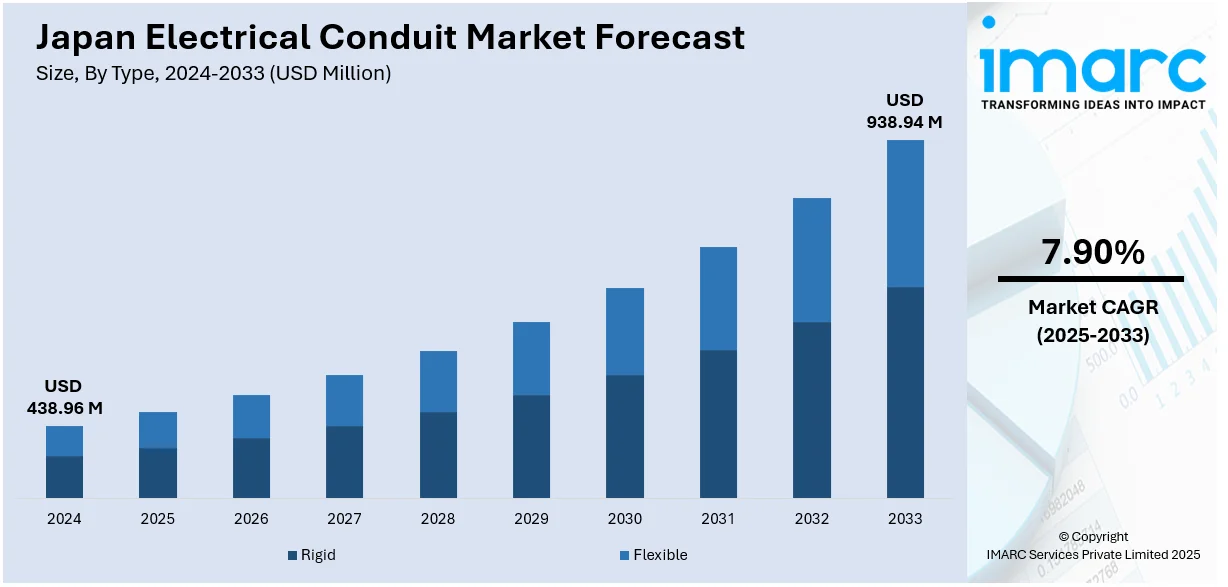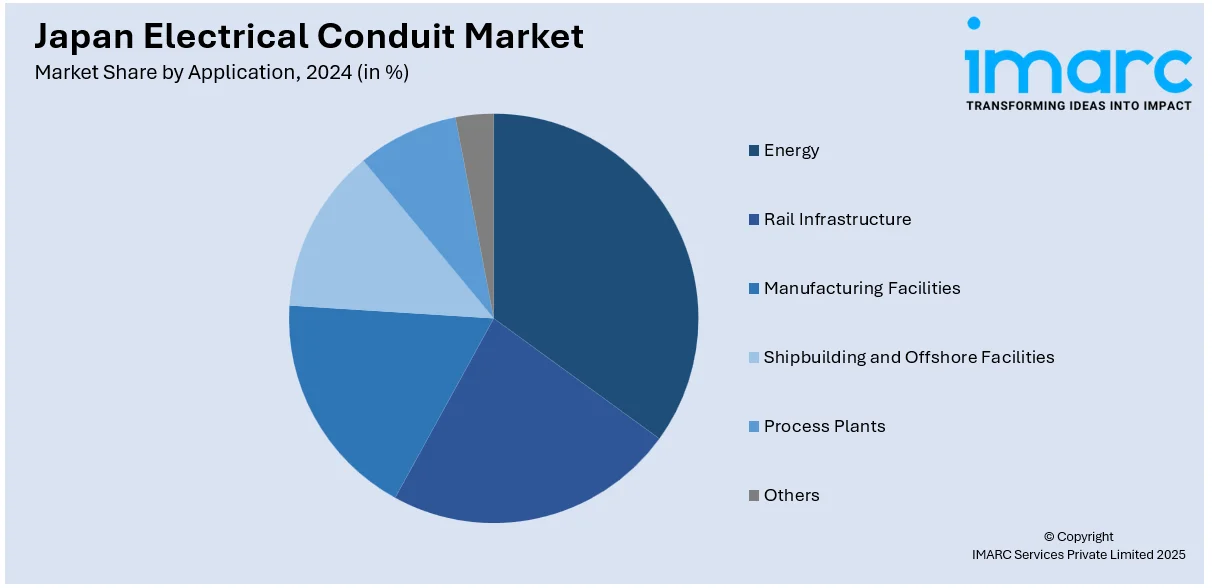
Japan Electrical Conduit Market Size, Share, Trends and Forecast by Type, Material, Application, and Region, 2025-2033
Japan Electrical Conduit Market Overview:
The Japan electrical conduit market size reached USD 438.96 Million in 2024. Looking forward, IMARC Group expects the market to reach USD 938.94 Million by 2033, exhibiting a growth rate (CAGR) of 7.90% during 2025-2033. The market is influenced by increasing demand for durable, high-quality materials and sustainable infrastructure. With a focus on energy-efficient solutions and regulatory compliance, Japan electrical conduit market share continues to grow, driven by innovations in manufacturing and construction practices.
|
Report Attribute
|
Key Statistics
|
|---|---|
|
Base Year
|
2024
|
|
Forecast Years
|
2025-2033
|
|
Historical Years
|
2019-2024
|
| Market Size in 2024 | USD 438.96 Million |
| Market Forecast in 2033 | USD 938.94 Million |
| Market Growth Rate 2025-2033 | 7.90% |
Japan Electrical Conduit Market Trends:
Emphasis on Sustainable Materials
In Japan, environmentally friendly materials in electrical conduit systems are increasing in popularity. With the increasing demand for sustainable building practices comes increased demand for environmentally friendly products that are safe and durable. Additionally, manufacturers of electrical conduits are meeting this demand through the production of materials from recyclable materials like aluminum and PVC, as well as carbon footprint-reducing systems in buildings. Furthermore, stringent regulations and governmental policies also enhance sustainability as they encourage green building methods. This trend can be observed in the increased adoption of green electric conduits in industrial, residential, and commercial applications, with both consumers and building firms focusing on a low environmental impact and energy efficiency. This transition to environmentally friendly materials not only promotes the well-being of the environment but also enhances the long-term efficiency and cost-effectiveness of electrical systems. As sustainability becomes a greater concern, the Japanese market for electrical conduit is expected to continue growing, with sustainable offerings capturing an increasingly greater share of the market.

Growing Need for Intelligent Infrastructure
The need for creative infrastructure solutions in Japan has driven demand for the electrical conduit market, with intelligent building solutions having a significant influence. To this end, there is an increasing demand for strong electrical conduit systems to accommodate high-tech electrical devices with the increased popularity of smart cities and intelligent building systems. The systems are instrumental in facilitating safe and efficient functionality of smart technology, including automation systems, renewable energy systems, and smart communication networks. To address such a need, manufacturers are focusing more on creating electrical conduits that are compatible with forthcoming technologies for effortless incorporation into smart infrastructure. The electrical apparatus of today demands breakthroughs such as conduit systems that offer greater fire resistance, ease of installation, and prevention of electromagnetic interference. The increase in smart buildings and infrastructure projects is fueling the Japan electrical conduit market growth, as the product plays a central role in guaranteeing the safety, efficiency, and connectivity of modern electrical networks. As the adoption of smart technologies continues to increase, the market for advanced electrical conduit systems is expected to expand significantly.
Japan Electrical Conduit Market Segmentation:
IMARC Group provides an analysis of the key trends in each segment of the market, along with forecasts at the country and regional level for 2025-2033. Our report has categorized the market based on type, material, and application.
Type Insights:
- Rigid
- Flexible
The report has provided a detailed breakup and analysis of the market based on the type. This includes rigid and flexible.
Material Insights:
- Metallic
- Non-Metallic
The report has provided a detailed breakup and analysis of the market based on the material. This includes metallic and non-metallic.
Application Insights:

- Energy
- Rail Infrastructure
- Manufacturing Facilities
- Shipbuilding and Offshore Facilities
- Process Plants
- Others
A detailed breakup and analysis of the market based on the application have also been provided in the report. This includes energy, rail infrastructure, manufacturing facilities, shipbuilding and offshore facilities, process plants, and others.
Regional Insights:
- Kanto Region
- Kansai/Kinki Region
- Central/ Chubu Region
- Kyushu-Okinawa Region
- Tohoku Region
- Chugoku Region
- Hokkaido Region
- Shikoku Region
The report has also provided a comprehensive analysis of all the major regional markets, which include Kanto Region, Kansai/Kinki Region, Central/ Chubu Region, Kyushu-Okinawa Region, Tohoku Region, Chugoku Region, Hokkaido Region, and Shikoku Region.
Competitive Landscape:
The market research report has also provided a comprehensive analysis of the competitive landscape. Competitive analysis such as market structure, key player positioning, top winning strategies, competitive dashboard, and company evaluation quadrant has been covered in the report. Also, detailed profiles of all major companies have been provided.
Japan Electrical Conduit Market News:
- May 2025: Mitsubishi Electric and Hitachi launched remote power inspection services using AI, sensors, and drones to detect abnormalities in power infrastructure. This innovation reduced the need for manual inspections, likely increasing demand for advanced electrical conduit systems to support these evolving monitoring technologies in Japan.
- December 2024: Sekisui Chemical announced plans to increase its CPVC compound output capacity in Thailand by 1.6 times, with the new plant expected to start by March 2026. This expansion is expected to drive demand for CPVC-based electrical conduit solutions, positively impacting market growth in Asia.
Japan Electrical Conduit Market Report Coverage:
| Report Features | Details |
|---|---|
| Base Year of the Analysis | 2024 |
| Historical Period | 2019-2024 |
| Forecast Period | 2025-2033 |
| Units | Million USD |
| Scope of the Report |
Exploration of Historical Trends and Market Outlook, Industry Catalysts and Challenges, Segment-Wise Historical and Future Market Assessment:
|
| Types Covered | Rigid, Flexible |
| Materials Covered | Metallic, Non-Metallic |
| Applications Covered | Energy, Rail Infrastructure, Manufacturing Facilities, Shipbuilding and Offshore Facilities, Process Plants, Others |
| Regions Covered | Kanto Region, Kansai/Kinki Region, Central/ Chubu Region, Kyushu-Okinawa Region, Tohoku Region, Chugoku Region, Hokkaido Region, Shikoku Region |
| Customization Scope | 10% Free Customization |
| Post-Sale Analyst Support | 10-12 Weeks |
| Delivery Format | PDF and Excel through Email (We can also provide the editable version of the report in PPT/Word format on special request) |
Key Questions Answered in This Report:
- How has the Japan electrical conduit market performed so far and how will it perform in the coming years?
- What is the breakup of the Japan electrical conduit market on the basis of type?
- What is the breakup of the Japan electrical conduit market on the basis of material?
- What is the breakup of the Japan electrical conduit market on the basis of application?
- What is the breakup of the Japan electrical conduit market on the basis of region?
- What are the various stages in the value chain of the Japan electrical conduit market?
- What are the key driving factors and challenges in the Japan electrical conduit market?
- What is the structure of the Japan electrical conduit market and who are the key players?
- What is the degree of competition in the Japan electrical conduit market?
Key Benefits for Stakeholders:
- IMARC’s industry report offers a comprehensive quantitative analysis of various market segments, historical and current market trends, market forecasts, and dynamics of the Japan electrical conduit market from 2019-2033.
- The research report provides the latest information on the market drivers, challenges, and opportunities in the Japan electrical conduit market.
- Porter's five forces analysis assist stakeholders in assessing the impact of new entrants, competitive rivalry, supplier power, buyer power, and the threat of substitution. It helps stakeholders to analyze the level of competition within the Japan electrical conduit industry and its attractiveness.
- Competitive landscape allows stakeholders to understand their competitive environment and provides an insight into the current positions of key players in the market.
Need more help?
- Speak to our experienced analysts for insights on the current market scenarios.
- Include additional segments and countries to customize the report as per your requirement.
- Gain an unparalleled competitive advantage in your domain by understanding how to utilize the report and positively impacting your operations and revenue.
- For further assistance, please connect with our analysts.
 Request Customization
Request Customization
 Speak to an Analyst
Speak to an Analyst
 Request Brochure
Request Brochure
 Inquire Before Buying
Inquire Before Buying




.webp)




.webp)












